Finally, this year I came up with a much easier way
to tie the fly if you follow the steps. One major
step is to do everything you can to avoid the habitual
shank tie. There is, in effect, very little tying as
you will see and most of the fly is done before you
even tackle the vise.
Materials List:
Hook: 1/0, 2/0 short shank Varivas.
Thread: White Danville.
Weight: Small to medium Lead Dumbell.
Body: Craft foam, tan or brown, Ring Neck
pheasant feathers, epoxy coating.
Eyes: 10 Pound mono, burnt, black paint, epoxy covered.
Legs: Six Indian neck grizzly hackles, or others.
Claws: Ring neck Pheasant feathers, different ones from the body.
Mouth: Krystal flash and rabbit strip cut to shape.
Misc.: Epoxy and Sally Hansen Hard As Nails.
Instructions - Crab Apple:
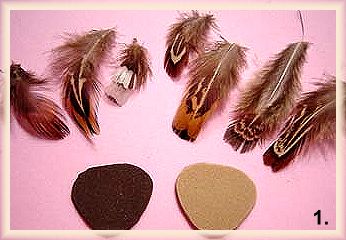
1. Here is a selection of the various neck feathers you
can choose to use for this fly. Keep in mind that, generally,
no two flies are alike. This is because you will find yourself
using different patterns and combinations. I cut a piece of
tan or brown foam. This will be tan foam and the one I will
use most often. The idea is to capture as best you can the
natural look of the mud or brown crab which are all over the
Cape.
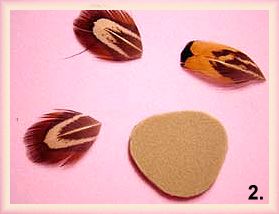
2. In step two I choose three feathers and cut away the
furry base ends and have what I think are three feathers
that should cover the carapace. If your carapace is bigger
or smaller, the pheasant will provide you with the right
size you need, or in smaller ones you can just cut it down.
Be sure you use one which has a natural pattern which will
imitate the irregular brown look of a Brown Crab.
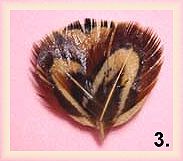
3. In step three I mix a small amount of epoxy and cover
the top portion of the foam with a thin layer of epoxy,
just enough to suck up the feathers. I place the first
one over the middle of the foam. Toward the front or
mouth of the crab. Then take the two others and put them
on in the angle shown. You may have to use your fingers
to move it a bit, but not to much since the wet feathers
will bunch up and not do what you want them to do. Be
sure when you put them on that you allow a little of
the feather tips to hang over where you will have the
mouth of the fly. Let set up.
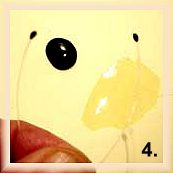
4. As your carapace is setting, make your eyes the old
fashioned way, by burning the opposite tips of a short
piece of mono. Then either dip the bulbs in black paint
or color with a magic marker. After the paint dries,
dip them in (lightly, so they don't drip) a small mixture
of epoxy, twist around in your fingers to be sure they
form nice and round if possible, set aside.
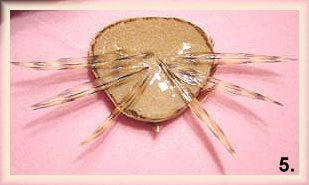
5. Now go back to the carapace with the dry set epoxy and
flip over. Take six tips of Indian Neck Dark Ginger hackle
or, in this case Indian Cock neck #1 Variant hackle.
Cut the base fluff off. Obviously you can use tips of
some other hackle - preferable a dark color or just brown.
Now, take a small amount of epoxy and lay on the spots where
you want to lay the legs as shown and let set.
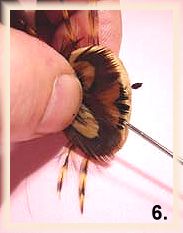
6. After it has set, take a bodkin and push two holes
in the front of the carapace where your eyes will be
put in. Cut the mono eyes down to size. To make it
easy cut the mono eyes to about ½ inch so you can push
then into the bodkin holes easily with a little goop
on the mono.
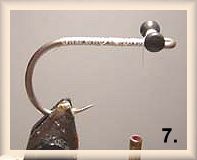
7. Now go to the vice and prepare the hook. In this case
I use a 2/0 wide gap Varivas short hook. Cover the entire
shank with white thread and tie your medium dumbbell eyes.
Here I have tied them at the hook eye. This will make the
crab sit on the bottom with it's claws facing up. But you
can, and I usually will, tie in the dumbbell at the center
of the shank so that the fly sinks right down on it's
stomach on the sand.
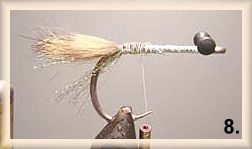
8. Tie in a small clump of crystal flash, use a dark
color of your choice. Then tie in on top of that a short
clump of brown or natural tan rabbit strip as shown.
Trim down as shown in finished fly, but do it now.
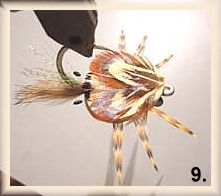
9. Now, Invert the hook and super glue the carapace on the
shank as shown. Be sure to make sure you are centered.
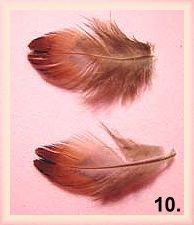
10. Choose two pheasant Feathers for the claws. I like
these because of the natural shape depicting actual claws
with that black line down the center of the feathers.
Looks like closed claws. I have used other feathers as
shown in step 1 and cut them to give an open claw appearance.
Do not cut the fluff off. You will need some length, it is
ok to trim the fluff a little but you want this fluff to
give some movement in the water.
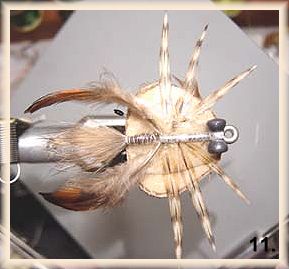
11. Now put the fly in the vise and invert. Place the
claws where shown with a little goop and then cover the
feather shanks with epoxy as well as the rest of the
bottom where the shank meets the foam. Remember if you
want your claws facing up a bit you will need to hold
them somewhat into position by pulling down slightly
while they set so that when you turn it over the claws
will be pointing up little. Take your time with this step,
you can make slight adjustments as the epoxy begins to set.
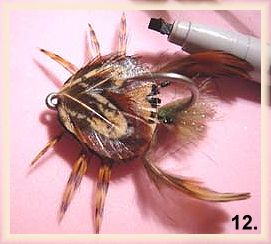
12. When the epoxy is set take a brown or black magic or permanent
marker and dot in some of the spaces between the feathers
and the foam, willy nilly.
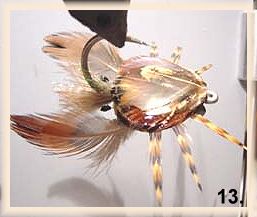
13. Now place the fly back in the vise as shown and mix
a portion of epoxy and carefully spread on top of the
carapace...make sure it fills in any holes and poke any
air bubbles with the bodkin. Let set, remove from hook
and cover with a generous portion of Hard As Nails.
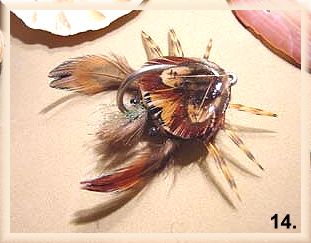
14. Here is the finished fly and ready to go.
How to Fish the Crab Apple:
Since you are using it for striped bass, I fish it
stationary. On the Monomoy flats I would cast it
well in advance of the cruising striper or several
stripers, let it settle and usually it will attract
a fish. If they are in the mood they will take.
They swim up, look quickly and grab it especially
if there is competition between them and in nature
there is. A solitary striper may take or not depending.
If I twitch it they run, but that is the case with most
crabs on those flats. Another successful way is the
dead drift on a strong current into a hole. In the
dead of summer the flats fishing is hard and cruising
striper may not be feeding. The look of the crab will
generally induce a strike, but you had better be prepared
to strike because they will spit it out if you wait to
long. Usually my crabs are a bit smaller for the
flats and larger for the dead drift. ~ John Morin



